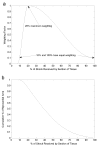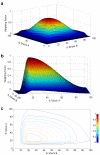Extended charge banking model of dual path shocks for implantable cardioverter defibrillators
- PMID: 18673561
- PMCID: PMC2527568
- DOI: 10.1186/1475-925X-7-22
Extended charge banking model of dual path shocks for implantable cardioverter defibrillators
Abstract
Background: Single path defibrillation shock methods have been improved through the use of the Charge Banking Model of defibrillation, which predicts the response of the heart to shocks as a simple resistor-capacitor (RC) circuit. While dual path defibrillation configurations have significantly reduced defibrillation thresholds, improvements to dual path defibrillation techniques have been limited to experimental observations without a practical model to aid in improving dual path defibrillation techniques.
Methods: The Charge Banking Model has been extended into a new Extended Charge Banking Model of defibrillation that represents small sections of the heart as separate RC circuits, uses a weighting factor based on published defibrillation shock field gradient measures, and implements a critical mass criteria to predict the relative efficacy of single and dual path defibrillation shocks.
Results: The new model reproduced the results from several published experimental protocols that demonstrated the relative efficacy of dual path defibrillation shocks. The model predicts that time between phases or pulses of dual path defibrillation shock configurations should be minimized to maximize shock efficacy.
Discussion: Through this approach the Extended Charge Banking Model predictions may be used to improve dual path and multi-pulse defibrillation techniques, which have been shown experimentally to lower defibrillation thresholds substantially. The new model may be a useful tool to help in further improving dual path and multiple pulse defibrillation techniques by predicting optimal pulse durations and shock timing parameters.
Figures






Similar articles
-
Optimizing defibrillation waveforms for ICDs.J Interv Card Electrophysiol. 2007 Apr;18(3):247-63. doi: 10.1007/s10840-007-9095-z. Epub 2007 Jun 1. J Interv Card Electrophysiol. 2007. PMID: 17541815 Review.
-
Intracardiac atrial defibrillation.Heart Rhythm. 2007 Mar;4(3 Suppl):S51-6. doi: 10.1016/j.hrthm.2006.12.030. Epub 2006 Dec 28. Heart Rhythm. 2007. PMID: 17336885 Free PMC article. Review.
-
Effects of defibrillation shock energy and timing on 3-D computer model of heart.Ann Biomed Eng. 1993;21(1):19-31. doi: 10.1007/BF02368161. Ann Biomed Eng. 1993. PMID: 8434817
-
Upper limit of vulnerability is a good estimator of shock strength associated with 90% probability of successful defibrillation in humans with transvenous implantable cardioverter-defibrillators.J Am Coll Cardiol. 1996 Apr;27(5):1112-8. doi: 10.1016/0735-1097(95)00603-6. J Am Coll Cardiol. 1996. PMID: 8609329
-
Single and dual coil shock efficacy and predictors of shock failure in patients with modern implantable cardioverter defibrillators-a single-center paired randomized study.J Interv Card Electrophysiol. 2019 Jan;54(1):65-72. doi: 10.1007/s10840-018-0443-y. Epub 2018 Sep 18. J Interv Card Electrophysiol. 2019. PMID: 30229405 Clinical Trial.
Cited by
-
Effects of high-frequency biphasic shocks on ventricular vulnerability and defibrillation outcomes through synchronized virtual electrode responses.PLoS One. 2020 May 1;15(5):e0232529. doi: 10.1371/journal.pone.0232529. eCollection 2020. PLoS One. 2020. PMID: 32357163 Free PMC article.
References
-
- Weiss G. Sur la possibilite de rendre comparables entre eux les apareils servant a l'excitation. Arch Ital de Biol. 1901;35:413–446.
-
- Lapique L. Sur l'excitation électrique de derfs traitée comme une polarisation. J Physiol Pathol Gen. 1907;49:620–635.
Publication types
MeSH terms
Grants and funding
LinkOut - more resources
Full Text Sources
Medical

